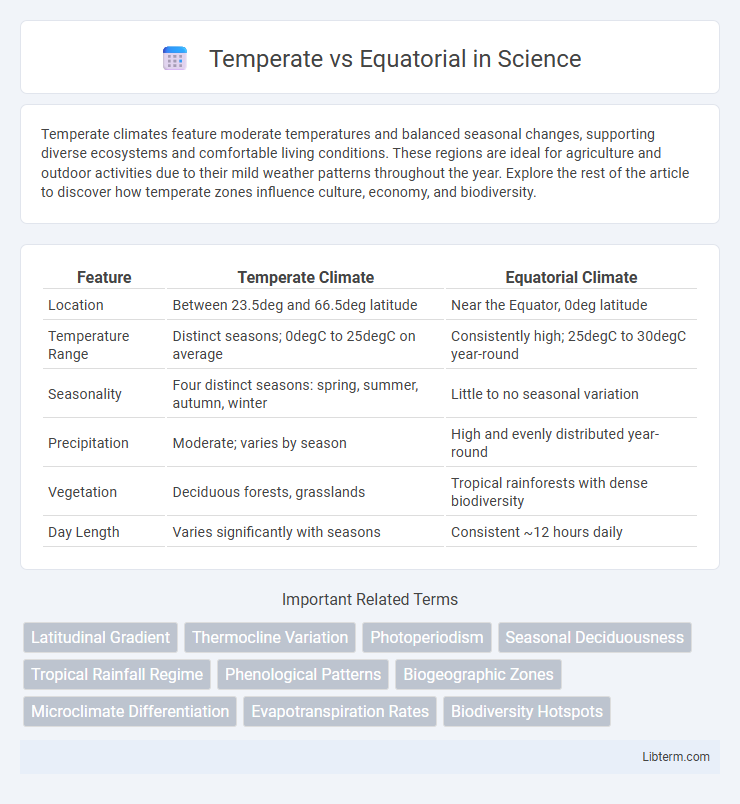Temperate climates feature moderate temperatures and balanced seasonal changes, supporting diverse ecosystems and comfortable living conditions. These regions are ideal for agriculture and outdoor activities due to their mild weather patterns throughout the year. Explore the rest of the article to discover how temperate zones influence culture, economy, and biodiversity.
Table of Comparison
| Feature | Temperate Climate | Equatorial Climate |
|---|---|---|
| Location | Between 23.5deg and 66.5deg latitude | Near the Equator, 0deg latitude |
| Temperature Range | Distinct seasons; 0degC to 25degC on average | Consistently high; 25degC to 30degC year-round |
| Seasonality | Four distinct seasons: spring, summer, autumn, winter | Little to no seasonal variation |
| Precipitation | Moderate; varies by season | High and evenly distributed year-round |
| Vegetation | Deciduous forests, grasslands | Tropical rainforests with dense biodiversity |
| Day Length | Varies significantly with seasons | Consistent ~12 hours daily |
Introduction: Defining Temperate and Equatorial Zones
Temperate zones encompass regions between the polar circles and the tropics, characterized by moderate seasonal temperature variations and distinct weather patterns. Equatorial zones lie along the equator, featuring consistently high temperatures and heavy, year-round rainfall with minimal seasonal changes. These climatic distinctions influence biodiversity, agriculture, and human settlement patterns within each zone.
Climate Characteristics: Temperate vs Equatorial
Temperate climates experience moderate temperatures with distinct seasonal changes, including cold winters and warm summers, while equatorial climates maintain consistently high temperatures and high humidity throughout the year. Precipitation in temperate zones varies seasonally, often with wet winters and drier summers, whereas equatorial regions receive heavy, year-round rainfall leading to lush, dense vegetation. These climatic differences influence biodiversity, agriculture, and human settlement patterns, with temperate zones supporting diverse crops adapted to seasonal changes and equatorial zones favoring tropical rainforests and perennial crops.
Geographic Distribution of Temperate and Equatorial Regions
Temperate regions are primarily located between 23.5deg and 66.5deg latitude in both hemispheres, encompassing much of North America, Europe, and parts of Asia and southern South America. Equatorial regions lie around the equator, between approximately 5degN and 5degS latitude, including the Amazon Basin, Central Africa, and parts of Southeast Asia. The distinct geographic distribution influences climate patterns, biodiversity, and ecosystems characteristic of temperate zones with seasonal variation versus year-round warm, humid conditions in equatorial zones.
Temperature Variations Across the Zones
Temperate zones experience significant temperature variations, with warm summers and cold winters due to the moderate solar angle changes throughout the year. Equatorial zones maintain consistently high temperatures year-round, typically ranging from 25degC to 30degC, driven by direct sunlight and minimal seasonal shifts. These differences impact local climates, vegetation, and wildlife adaptations within each zone.
Seasonal Changes: Contrasts and Impacts
Temperate regions experience distinct seasonal changes characterized by four well-defined seasons: spring, summer, autumn, and winter, with temperature variations influencing agriculture and wildlife behaviors. Equatorial zones maintain consistent temperatures year-round, resulting in minimal seasonal variation but marked by wet and dry periods that impact vegetation cycles and biodiversity. These contrasting seasonal dynamics shape ecosystem productivity, human activities, and climate adaptation strategies across both climatic zones.
Biodiversity and Ecosystem Differences
Temperate regions exhibit moderate biodiversity with ecosystems such as deciduous forests and grasslands adapting to seasonal changes, while equatorial zones boast the highest biodiversity with dense tropical rainforests hosting complex food webs and endemic species. Equatorial ecosystems maintain stable, warm temperatures and high humidity year-round, supporting continuous plant growth and diverse animal populations, contrasting with the more variable climates and migration patterns in temperate zones. The variation in sunlight intensity and rainfall between these biomes profoundly affects species richness and ecological interactions, highlighting the dynamic nature of ecosystem services across latitudinal gradients.
Human Adaptation and Lifestyle
Human adaptation in temperate regions involves seasonal behavioral changes and clothing adjustments to cope with fluctuating temperatures, promoting agricultural cycles aligned with spring and autumn. In equatorial zones, continuous high temperatures and humidity drive adaptations such as lightweight clothing, hut-style housing for ventilation, and diets rich in tropical fruits and tubers. Lifestyle in temperate areas emphasizes energy conservation and indoor heating during winters, while equatorial inhabitants prioritize hydration and shade to manage heat stress and maintain productivity.
Agriculture: Crop Types and Productivity
Temperate regions primarily support the cultivation of wheat, barley, and potatoes, benefiting from distinct seasonal temperature variations that facilitate crop rotation and soil nutrient replenishment. Equatorial zones favor crops such as cocoa, coffee, bananas, and oil palm due to consistent warmth and high rainfall, which enhance year-round growing cycles but can challenge soil fertility and pest management. Crop productivity in temperate areas often hinges on cold-resistant varieties and seasonal planning, while equatorial agriculture relies on managing humidity and optimizing crop choices for continuous growth.
Economic Activities and Natural Resources
Temperate regions support diverse economic activities such as agriculture, forestry, and manufacturing due to moderate climate and fertile soil, fostering crops like wheat, barley, and fruits alongside timber industries. Equatorial zones, characterized by abundant rainfall and high biodiversity, rely heavily on natural resources like tropical hardwoods, rubber, and minerals, with economies driven by plantation agriculture including cocoa, coffee, and oil palm. Resource distribution influences trade patterns, where temperate areas often export processed goods, while equatorial regions focus on raw material extraction and exportation.
Climate Change Effects: Temperate vs Equatorial
Climate change effects vary significantly between temperate and equatorial regions due to distinct climatic conditions and ecosystems. Temperate zones experience more pronounced seasonal shifts in temperature and precipitation patterns, leading to altered growing seasons and increased risks of droughts or floods. Equatorial regions face intensified heat stress and disrupted rainfall cycles, which threaten biodiversity and exacerbate challenges for agriculture and water resources.
Temperate Infographic

 libterm.com
libterm.com